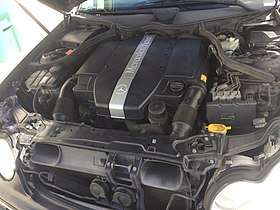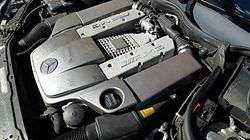Mercedes-Benz M112 engine
The Mercedes-Benz M112 engine is a gasoline-fueled, 4-stroke, spark-ignition, internal-combustion automobile piston V6 engine family used in the 2000s. Introduced in 1998, it was the first V6 engine ever built by Mercedes. A short time later the related M113 V8 was introduced.
| Mercedes-Benz M112 engine | |
|---|---|
 M112 motor in a 2002 C240, 2.6L | |
| Overview | |
| Manufacturer | Mercedes-Benz |
| Production | 1998-2015 |
| Layout | |
| Configuration | 90° V6 |
| Displacement | 2.4 L (2,398 cc) 2.6 L (2,597 cc) 2.8 L (2,799 cc) 3.2 L (3,199 cc) 3.7 L (3,724 cc) |
| Cylinder bore | 83.2 mm (3.28 in) 89.9 mm (3.54 in) 97 mm (3.82 in) |
| Piston stroke | 68.2 mm (2.69 in) 73.5 mm (2.89 in) 84 mm (3.31 in) |
| Block material | Aluminum |
| Head material | Aluminum |
| Valvetrain | SOHC 3 valves x cyl. |
| Combustion | |
| Supercharger | IHI Twin-screw type (in some versions) |
| Fuel system | Sequential fuel injection |
| Fuel type | Gasoline |
| Cooling system | Water cooled |
| Output | |
| Power output | 125–260 kW (170–354 PS; 168–349 bhp) |
| Torque output | 225–450 N⋅m (166–332 lb⋅ft) |
| Chronology | |
| Predecessor | first Mercedes-Benz V6 engine; last straight-six engine is the Mercedes-Benz M104 |
| Successor | Mercedes-Benz M272 |
All are built in Bad Cannstatt, Germany except the supercharged AMG C32 AMG, which is assembled in Affalterbach, Germany.
All M112 engines have aluminum engine blocks with a 90° vee angle with silicon/aluminum lined cylinders. The aluminum SOHC cylinder heads have 3 valves per cylinder. All use sequential fuel injection with two spark plugs per cylinder. All have forged steel connecting rods, a one-piece cast camshaft, iron-coated aluminum pistons and a magnesium intake manifold. To deal with the vibration problems of a 90 degree V6, a balancer shaft was installed in the engine block between the cylinder banks. This essentially eliminated first and second order vibration problems (see engine balance). A dual-length Variable Length Intake Manifold is fitted to optimise engine flexibility.
E24
The E24 is a 2.4 L (2,398 cc) version. Bore and stroke is 83.2 mm × 73.5 mm (3.28 in × 2.89 in). The engine produces 168 bhp (125 kW; 170 PS) between 5500 and 6000 rpm and 225 N⋅m (166 lb⋅ft) of torque between 3000 and 5500 rpm. The compression ratio is 10.0:1.[1]
Applications:
- 1997-2000 C240
- 1998-2000 CLK240
- 1998-2000 E240
E26
The E26 is a 2.6 L (2,597 cc) version. Bore and stroke is 89.9 mm × 68.2 mm (3.54 in × 2.69 in). Output is 125 kW (170 PS; 168 bhp) ECE at 5,500 rpm 240 N⋅m (177 lb⋅ft) of torque at 4,500 rpm in all applications except in the 2003-2005 W211 E-Class where power rose to 130 kW (177 PS; 174 bhp). The compression ratio is raised to 10.5:1.[1]
Applications:
E28
The E28 is a 2.8 L (2,799 cc) version. Bore and stroke is 89.9 mm × 73.5 mm (3.54 in × 2.89 in). It produces 204 bhp (152 kW; 207 PS) at 5,700 rpm and 270 N⋅m (199 lb⋅ft) of torque between 3,000 and 5,000 rpm. The compression ratio is 10.0:1.[1]
Applications:
E32
The E32 is a 3.2 L (3,199 cc) version. Bore remains at 89.9 mm (3.54 in) but the engine is stroked to 84 mm (3.31 in). Output is 215-224 bhp ECE at 5,700 rpm (depending on model) with 315 N⋅m (232 lb⋅ft) of torque at 3,000-4,800 rpm. The compression ratio is 10.0:1. It has fracture-split forged steel connecting rods.[1]
Applications:
- 2000–2004 C320
- 1998–2005 E320
- 1997-2006 G320
- 1998–2005 S320
- 1998–2003 ML320
- 2000–2003 SLK320
- 1998–2005 CLK320
- 2010–2015 Viano 3.0/Vito 119 (W639)
- 2004-2008 Chrysler Crossfire
E 32 ML

The E 32 ML is a special version of the 3.2 L (3,199 cc), fitted with a helical Twin-screw type supercharger and water-to-air intercooler. The supercharger was developed in conjunction with IHI and features Teflon-coated rotors producing overall boost of 14.5 psi (1.00 bar). Output is 260 kW (354 PS; 349 bhp) ECE at 6,100 rpm with 450 N⋅m (332 lb⋅ft) of torque at 3,000-4,600 rpm. The compression ratio is 9.0:1.[1]
Applications:
E37
The E37 is a 3.7 L (3,724 cc) version. It retains the stroke of the E32 but is bored to 97 mm (3.82 in). Output is 173 to 180 kW (235 to 245 PS; 232 to 241 bhp) ECE at 5,750 rpm with 344 N⋅m (254 lb⋅ft) of torque at 3,000-4,500 rpm. The compression ratio is 10.0:1.[1]
Applications:
See also
References
- "Mercedes-Benz M112 V6 petrol engine". motor-car.net. Retrieved 8 January 2020.